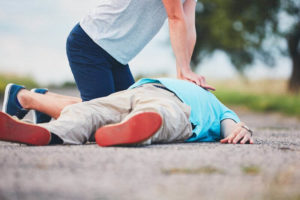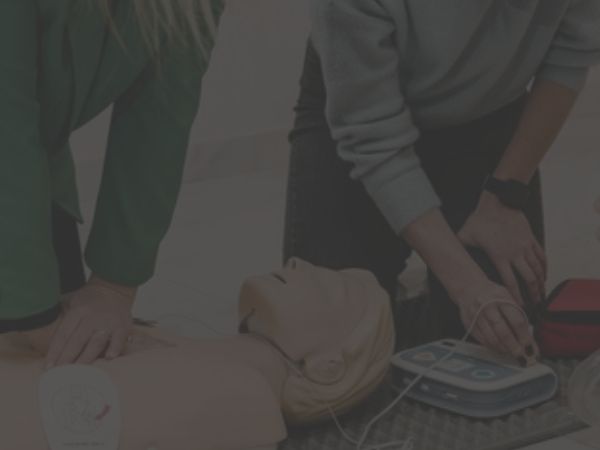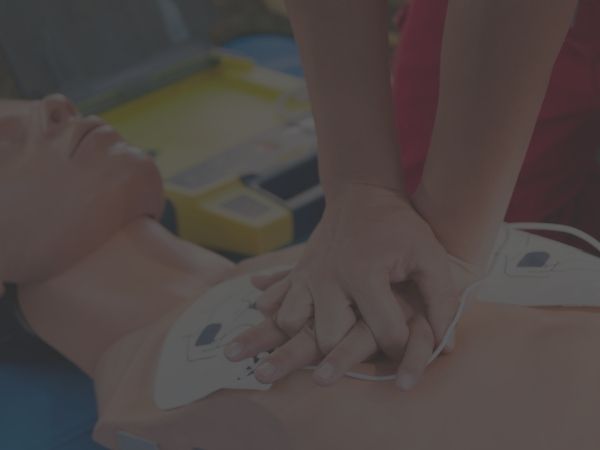Your cart is currently empty!
Agonal Breathing: How to Spot It & What to Do
What is agonal breathing? According to Merriam-Webster.com, when something is agonal, it’s related to the act of dying and is characterized by the potential for extreme suffering, agony. Agonal breathing is the medical term for a certain type of gasping for air, usually during a serious medical emergency like a stroke or heart attack.
This gasping may appear conscious. But it is commonly a reflex managed by the brain stem. This primal part of the brain handles life-saving functions when the rest of the brain isn’t aware of what’s happening. Depending on the cause of agonal breathing, the person may or may not be conscious. This agonal respiration most often happens after the heart has stopped.
So there is no blood being pumped to the brain, or anywhere else. During such an event, seconds matter.
If the heart is not restarted, this person may experience brain damage and permanent death in short-order.
A person who is not medically trained may see agonal breathing and falsely think that the person’s heart must be beating if they’re still breathing.So, sadly, you might think they have time to wait for an emergency response. But that is not the case. Once agonal breathing begins, a person may have two to three minutes.
For this reason, it’s important to know what agonal breathing looks like. You can take steps to save this person’s life, and quality of life, by learning CPR?
Symptoms of Agonal Breathing?
Agonal breathing sounds like this.
- Gasping
- Snorting
- Sometimes moaning
- Sporadic breathing, not in quick succession
The person having the event pauses between breaths. This will seem abnormal to you since people who know they can’t breathe usually inhale/exhale quick, short breaths.
A person who is experiencing agonal respiration breathes about 10-12 breaths a minute, slowly. According to Clevelandclinic.org, the average person who is not in distress breathes 12-25 times a minute. So unless this person is a slow, yoga-style breather, you’ll notice a contrast.
You may also see the twitching of bodily muscles, which may lead you to believe their heart is beating. This is likely a reflex as well.
Unconsciousness is, by far, the most common scenario. But if the person is conscious, they will lose consciousness as the episode continues. During that conscious time, you may see other signs like:
- Droopy face
- Lack of coordination
- Overwhelming, worst headache ever
- Slurred speech
- Half of the body going limp
- Inability to understand what you’re saying
Then they become unconscious.
Agonal Breathing Vs. Other Breathing Conditions
To further understand how to identify agonal breathing, let’s look at some conditions that could be confused with it.
Death Rattle Vs. Agonal Respiration
A death rattle is a layman’s term for the last breathing before a person passes. This does look and sound similar to agonal breathing. But death rattle is normally more of a gurgling sound as if the lungs were filling with fluid.
The other big difference is that death rattle is typically experienced by someone who is in the last stages of dying. They may have advanced age or have been sick for a while.
On the other hand, agonal breathing often happens out of the blue. It is brought on by a sudden health event. This is not the final breath of someone faced with a prolonged, terminal illness. It is a sign of someone who may go on to live a productive life if the people around them act fast and get them the medical attention they need.
COPD
According to Mayoclinic.org, a person with Chronic Obstructive Pulmonary Disease may experience shortness of breath when they expend themselves, accompanied by coughs and wheezing.
Unlike agonal respiration, COPD develops over time, usually from smoking or exposure to harmful airborne chemicals. A person who is having a particularly severe COPD attack is usually very conscious and able to move normally.
The same applies to asthma attacks.
PE
According to MedlinePlus.gov, Pulmonary Embolism is a sudden blockage in the pulmonary (lung) artery. Many people who have PE have no symptoms leading up to a major clot. But when they do, they experience chest pain, shortness of breath, and coughing up blood.
Lung Cancer Breathing
According to the University of Rochester Medical Center, those with lung cancer have trouble filling the lungs and expelling the air, causing shortness of breath.
Once again, a person with lung cancer is likely to be more aware and applying techniques like leaning forward of pursed-lip breathing to ease the discomfort and improve airflow.
What Causes Agonal Breathing?
Here are the five most common causes.
- Cardiac arrest, heart attack, during which the heart stops beating because the signals that tell the heart to beat stop. When the heart stops, other organs also stop because they’re no longer receiving oxygen rich-blood. It will only take a few minutes in this state for the person to “officially” die. After that, revival may or may not be possible.
- An Ischemic Stroke, also known as cerebral ischemia, happens when the blood that is going to the brain lacks sufficient oxygen. This normally happens because of a clot or clogged artery.
- A Hemorrhagic stroke is caused by bleeding arteries, which makes blood flow so inefficient that the organs get depleted of oxygen.
- Drug overdose shuts the body’s vital systems down.
- Anoxia is a catch-all for any complete oxygen deprivation. It could refer to someone who has just been rescued from an episode of near-drowning, choking, strangulation, severe asthma attack, or intentionally cutting off their blood supply for various reasons, etc. Anoxia is much worse than hypoxia, which is when the brain can still get some oxygen and prioritize it to survive for a while. Anoxia means the body is getting no oxygen and only has minutes. Thus the agonal breathing.
Bottom line: When the brain doesn’t have enough oxygen, it may activate this survival mode function.
Given the popularity of pass out social media challenges and the inherent risks of playing, it’s especially important for daycare professionals, teachers, and parents to learn what to do if someone starts agonal breathing even if they didn’t see what preceded it.
How Dangerous is Agonal Breathing? Seconds Matter
According to FDA.gov, a person’s chance of survival decreases by as much as 10% for every minute they don’t have a heartbeat.
 A person who experiences agonal respiration may stay alive for five minutes. There is a possibility to revive the person after that. But according to MedlinePlus.gov, within five minutes of oxygen depletion, brain cells begin to die. Within 10 minutes, significant organ and brain damage may occur.
A person who experiences agonal respiration may stay alive for five minutes. There is a possibility to revive the person after that. But according to MedlinePlus.gov, within five minutes of oxygen depletion, brain cells begin to die. Within 10 minutes, significant organ and brain damage may occur.
According to Reuters.com, the average ambulance takes 14 minutes to arrive. And 10% of Americans will wait at least 30 minutes for an ambulance.
So calling 911 and then just waiting for help to arrive is not likely to save this person’s life. But you can take control in this situation, preserve life and brain function.
What to Do If Someone Experiences Agonal Respiration
Note: This article is not a complete guide to CPR or a replacement for CPR training. But the following are the next steps that you learn to do in a CPR training program confidently.
1. Makes Sure Professionals Are On Their Way
If there are two or more people around, get someone to call 911 if someone is having a medical emergency, regardless of what it is. If you’re alone, call for help while attending to the person. If no one arrives to help you, call 911 to get medical help on its way while attending to the person.
2. Determine if this is Agonal Breathing
Next, quickly decide if this is agonal breathing. Time the gasps. Less than 13 a minute and sporadic? It’s probably agonal breathing.
3. Try to Get the Person to Respond to You
Unless you think they may have experienced a trauma to the neck or spine, gently shake them. Shout at the person to see if they respond. A person having a stroke may be able to respond to you. Cardiac arrest victims will not.
If the person responds, they’re unlikely to be in cardiac arrest. But it would help if you prepared for that possibility while you await the ambulance.
If they do not respond, check their pulse to see if the heart is beating. Remember: Sporadic jerky movements are not responses. Those are reflexes caused by the brain stem.
Only proceed to the next step if you determine that the heart isn’t beating. Otherwise, wait with them and try to keep them awake while help arrives.
4. Retrieve and Prepare the AED
Retrieve an automated external defibrillator (AED), if one is available. These devices often include voice prompts or short written steps that walk you through what to do. You will set up the AED quickly before beginning CPR so that it’s ready if needed.
The AED will monitor heart activity as you perform CPR and alert you if the person needs a shock.
According to FDA.gov, many people don’t realize that AEDs are in almost every business, school, and public location and accessible to anyone. They’re often hanging on walls in easy to access areas near emergency exits, restrooms, break rooms, nurse’s station, etc.
5. Begin CPR
Start CPR. Our Adult Basic Life Support (BLS) Algorithm walks you through these steps, although the event should not be the first time you review them.
If you suspect this person is having an opioid overdose, then follow Opioid Overdose CPR guidelines.
You do chest compressions at a rate of 100-120 a minute. The best way to keep this rhythm is to think of a fast song in your head.
6. Keep Your Rhythm
Oddly enough, the 1977 song “Stayin’ Alive” by the Bee Gees has the appropriate pace, according to Beegees.com.
Not a disco fan? That’s okay. You’re certain to be familiar with one of these popular substitutes.
- “Crazy in Love” by Beyoncé
- “Just Dance” by Lady Gaga
- “Rock Your Body” by Justin Timberlake
- “Whenever, Whatever” by Shakira
- “Rock This Town” by Stray Cats
- “Baby Shark” by Pinkfong
- “Te Duele” by Gente de Zona
- “Feels Like the First Time” by Foreigner
NewYork-Presbyterian Hospital compiled these and other songs on a Spotify.com playlist. We’re sure one of these songs is now stuck in your head. Sorry about that. It’s for a good cause.
7. Use the AED if prompted
If your AED device tells you to shock the person, follow the instructions and do so. Some AEDs will do this automatically once the pads have been placed.
8. Continue CPR
If the heart doesn’t restart, continue CPR until the ambulance arrives. Do not stop CPR once you have started unless it is obvious to you that things are returning to normal.
Some of those signs include:
-
- They wake up and look/sound responsive
- They start breathing normally
- They start moving around as if disoriented (not reflex movements) or moving normally
- They express a feeling of pain beyond the moaning of agonal respiration
- They respond to touch
Try to keep the person awake if they wake up. They need to be checked on by a doctor.
CPR Training: Being Ready for an Emergency
Anyone could be faced with an emergency that requires CPR, nurses, teachers, daycare administrators, grocery store managers, to name a few.
Getting CPR training gives you the confidence you need to save a life. When second matters, it’s that confidence that helps you know exactly what to do and do it while staying calm. Getting certified also looks great on anyone’s resume. Hiring managers like to know that some of their employees know what to do in an emergency.
In some professions, getting certified may even increase pay potential or be required to keep your certification.
At Save a Life by NHCPS, we offer CPR, AED & First Aid Certification. Our programs adhere to the industry-accepted ILCOR standards and guidelines. We are Joint Commission Compliant and nationally accepted 98% of the time.
You’ll be ready for an agonal respiration emergency, and thousands more like it after completing this 100% online training course.
We encourage you to check out our CPR, AED & First Aid Certification program.
Keep Reading
4 responses
Michelle, Thank you for sharing your story with us. We are so sorry for your loss, and we hope that we can help prevent this from happening to others! Again we really appreciate you sharing your story and awareness about agonal breathing. Our deepest condolences go out to you and your family.
This is such an informative post! I had no idea how crucial it is to recognize agonal breathing in emergencies. The tips on what to do next are really helpful. Thanks for shedding light on this important topic!
You’re very welcome! We’re glad you find this topic helpful.










I wanted to say this article is spot on . My mother just passed away from cardiac arrest Feb. 1st , and while I am a trained CNA and have been trained in CPR for over 15 years I was not prepared for this . I have spent the past month trying to figure out what happened in those last few minutes that could have saved her . The saddest part is I was with her when she started going into cardiac arrest . She wasn’t able to catch her breath , and was bent over the sink cause to bend over helped , I went to call 911 and she said no but I proceeded to dial as she opened door to get more air she turned to me and said my name and help me . Then passed out , 911 asked if she was breathing and we said yes but it’s not normal it’s like gasping for air , they said ok they are on way , a few minutes went by or so it seemed then they said start chest compressions only . So my husband did and for truck got there a minute later . They could not find pulse ambulance took 40 minutes then 10 to hospital . 50 minutes no blood oxygen to brain and did I mention they live 10 minutes from a hospital I took her off ventilator at 11:02 pm that night all organs where failing and heart was not beating right without help . As a CNA I myself felt like a failure . I honestly remember being almost in a state of shock . We had daycare children that day because she had a home daycare . I had to call every parent before I could even go to hospital with my dad . Oh and did I mention he has dementia . This has been the hardest thing I’ve ever been through in my life . So let me just state for the person that is ever in the same position it is normal to panic , it is normal to be in shock and freeze , even trained professionals do it !!!! I wish someone would have said that to me . We where always told you will be able to do it adrenaline will kick in . Not in every case , so do not blame yourself if you find yourself there one day. I just kept thinking she was breathing it’s going to be ok , wish I would have known about agonal breathing 😞